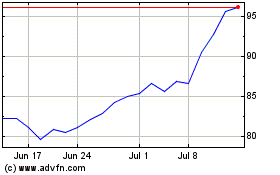Asia Currencies Hit by ECB Easing, but Stocks Mostly Gain
December 08 2016 - 11:30PM
Dow Jones News
Asian currencies were hit Friday by a perceived policy easing by
the European Central Bank, even as stock-market reaction was mostly
positive.
Japan's Nikkei was up 1.1%, Australia's S&P/ASX 200 gained
0.3% and Taiwan's Taiex was up 0.1%.
The ECB said Thursday it would extend its bond-purchase program
by nine months to the end of 2017, but cut its monthly purchases to
€60 billion ($64 billion) from €80 billion, as of April.
The ECB action combined tightening and loosening measures, but
markets chose to focus on the extension of the asset-purchase
program, known as quantitative easing, or QE.
"More QE removes concerns," said Alex Furber, a sales trader at
CMC Markets. "It gives investors confidence."
The ECB decision triggered a sharp drop in the euro in late New
York trading, bolstering the U.S. dollar broadly. That spilled over
into Asian trading Friday, sparking losses in Asian currencies
against the dollar, said Khoon Goh, head of Asia research at ANZ.
"The broad dollar move is still a very important factor in driving
Asian currencies," he added.
China set the yuan 0.35% weaker against the U.S. dollar Friday,
fixing the daily dollar-yuan midpoint at 6.8972, compared with
6.8731 on Thursday. Depreciation pressure for the yuan has picked
up in recent days, with the dollar-yuan rate in the offshore market
rising above 6.91.
The Korean won was down 0.5% against the dollar, partly due to
the volatile political situation there: South Korean President Park
Geun-hye is widely expected to be impeached by lawmakers today. The
Korea Kospi was also down 0.4%.
In Japan, the yen was off 0.4% against the dollar. The yen's
weakening helped Japan's export-oriented stock, as a devalued yen
makes their goods cheaper in dollars. Sony gained 3.1% and Honda
Motor was up 0.7%.
The Shanghai Composite was up 0.2% after solid economic data was
released Friday.
China's producer price index rose 3.3% in November from a year
earlier, flagging improved demand and pricing power for China's
industries. The reading from the National Bureau of Statistics for
factory-gate prices came in much stronger than economists' median
forecast of a 2.4% increase.
China's consumer price index increased 2.3% in November from a
year earlier, beating the median forecast for a 2.2% gain from a
survey of economists by The Wall Street Journal.
However, that did not help the Hang Seng Index, which was
trading down 0.6%, partly due to a sharp selloff in casino
stocks.
The South China Morning Post reported that the daily ATM
withdrawal limit in Macau for China UnionPay bank card holders will
be cut by half to 5,000 patacas (US$626). The capital outflow
measure cuts the sums that the Chinese can gamble in the special
administrative region.
Galaxy Entertainment tumbled 8.5%, Sands China dropped 8.6% and
MGM China fell 7.4% in early trade Friday.
The China market is still largely being weighed down with
capital outflow and the yuan depreciation, said Andrew Sullivan,
managing director of sales trading at Haitong International
Securities.
Saumya Vaishampayan, Liyan Qi, Saumya Vaishampayan and Kenan
Machado contributed to this article.
Write to Willa Plank at willa.plank@wsj.com
(END) Dow Jones Newswires
December 08, 2016 23:15 ET (04:15 GMT)
Copyright (c) 2016 Dow Jones & Company, Inc.
Sony (NYSE:SONY)
Historical Stock Chart
From Mar 2024 to Apr 2024

Sony (NYSE:SONY)
Historical Stock Chart
From Apr 2023 to Apr 2024
